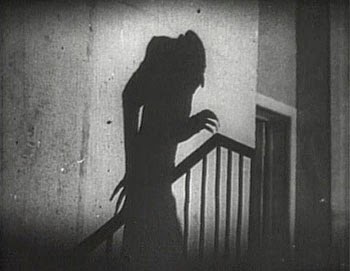Later in the opening we see the use of real life footage, which helps to add a sense of gritty realism to the production. The title sequence to 'Psycho' uses very similar imagery.
When we are introduced to Holly Martins we see that he is a very innocent and naive character, on his way to see Harry Lime who we learn is very whimsical and devious; despite the audience not actually being introduced to the character yet. On Holly's journey he is seen walking under a ladder lent against a wall, this being used ironically to play on the superstition of it being bad luck.
The superstition arose from a Christian belief in the Holy Trinity- that God is made up of three parts, the Holy Father, the Holy Son, and the Holy Spirit. Thus, the number three was somewhat sacred, and the triangle was by association also sacred with its three sides. A ladder leaning up against a building was seen as a triangle, so to walk through this triangle (by walking under the ladder) was seen as breaking the Trinity. The bible talks about the one unforgivable sin being blaspheming against the Holy Spirit, so someone who breaks the Trinity is seen to be in league with the Devil; and once again, being labelled such in the old days of Christianity was a quick way to invite the hangman and witch trials. Similar to the use of the floating body in the opening, this feature could have been used to foreshadow later events. Alternatively, as Holly only walked under the ladder to get to Harry Lime, this could be suggesting that Harry is bad news and could possibly corrupt Holly; who has been portrayed to the audience as a naive, innocent character.
When Holly gets to where Harry lives, we see him ascend a large staircase - of which being a generic thriller location; also seen in the opening of Danny Boyle's 1994 'Shallow Grave'.
The use of non-ambient lighting helps to create very heavy shadowing on the scene, the shadow behind Holly suggesting enigma and mystery- possibly in reference to the character of Harry Lime. This use of heavy shadowing is similar to that seen in 'Nosferatu the Vampyre' (1929).


The audience are made to sympathise with Holly from early on in the film, as on the staircase he encounters a German man who proceeds to talk to him, with Holly not understanding what he is saying. As there are no subtitles for the German man's dialogue, the audience are put with/in Holly's place as we don't understand what he is saying either. This could help to elicit a response from the audience that leads them to believe he is the innocent party, and -much like the audience themselves- watching the events unfold as they happen, with him having the same knowledge of the occurrences as the audience does.
Later in the film, we see a tilt shot of a Gothic doorway where a cat is sat; the tilt possibly used to signify Holly's confusion and disorientation when we see Harry Lime for the first time - whom we were led to believe was dead. Much like with the use of the ladder earlier, cats are linked to superstition; as well as witchcraft, reinforcing Harry Lime as a fairly negative and phantom-like character.
This further links to 'Nosferatu', as when we first see Harry Lime the lighting is the same used in 'Nosferatu' when establishing the character, further linking the character of Harry Lime to a phantom or supernatural being; reinforced by him suddenly vanishing into the night when he is seen by Holly. Harry is later seen emerging from the shadows atop a building, which portrays enigma and vampiric connotations, once again strengthening the comparason between Harry Lime and Nosferatu.

The pinnacle moment in the film is when Harry is chased down into the sewers, the claustrophobic setting creating a foreboding sense of suffocation; as well as possibly eliciting a fear response from the audience as many people have a fear of closed in spaced - helping to build tension within the audience. The use of such location creating a prominent vanishing point which could possibly suggest that there is no redemption for Harry, highlighted by the use of chiaroscuro lighting which helps to connote surrealism whilst also adding aesthetic appeal to the mise en scene; the shadowing it creates connoting nightmare and a sense of mystery. The sewer location helps to signify Harry's decent into the depths, much like a rat he plagues an poisons the innocent - as we find that he has been indirectly killing children by stealing drugs from hospitals to sell on the black market.
.jpg)




An excellent case study. I like the way you have referenced "Nosferatu The Vampyre" and that the vanishing point in the sewer sequence indicates that there is no redemption for Harry Lime.
ReplyDeleteA pleasure to read.